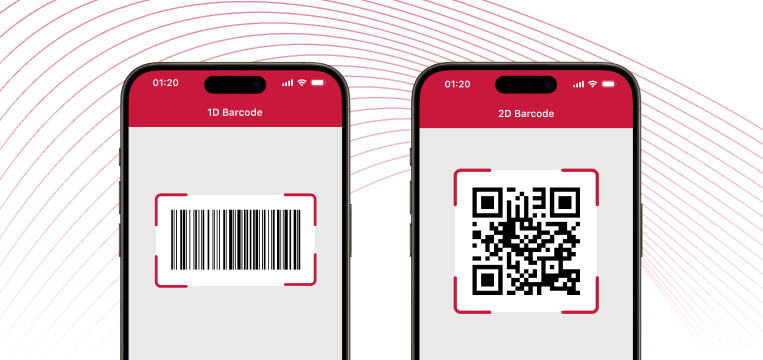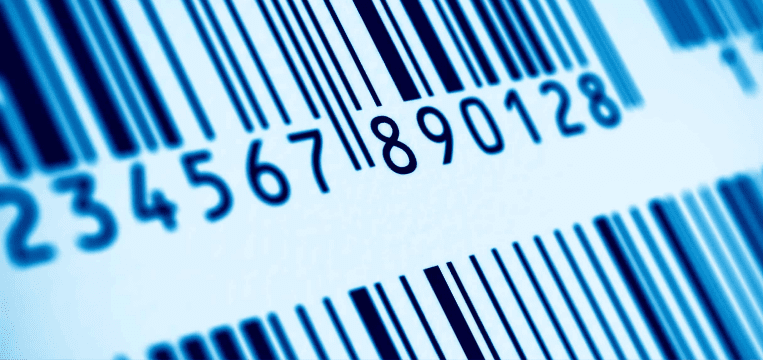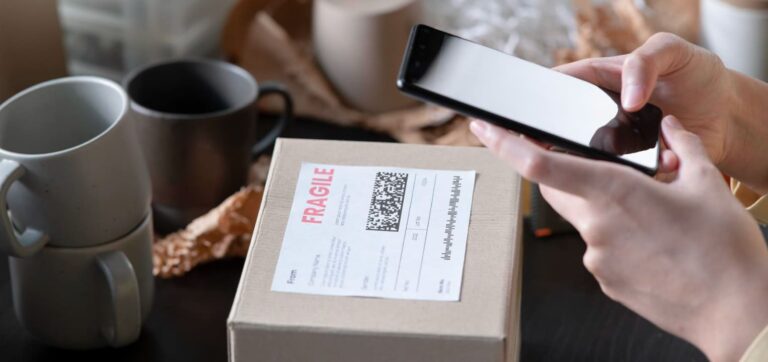Advantages of 1D barcodes
One-dimensional barcodes were introduced in the 1970s and have been pushed to the limit since. Many different symbologies exist, often tailor-made for specific use cases.
1D barcodes have a relatively simple structure: A specific sequence of bars of varying widths corresponds to exactly one character. This also makes it easy to create 1D barcodes yourself. There are even fonts that print the correct bars for every keyboard stroke on the screen.
Their simplicity makes one-dimensional barcodes an all-round tool for all kinds of use cases. Since they’ve been around for five decades, many hard- and software systems support them by default. If all you need is to encode a string of numbers or characters in a barcode to be scanned in favorable conditions, 1D barcodes are a good option.
Disadvantages of 1D barcodes
In the 50 years since the introduction of the first 1D barcode, technology has advanced at an unprecedented pace. This also led to the emergence of advanced barcode features that are not suitable for the simple structure of traditional symbologies.
One of these features is automatic error detection and correction. While some 1D symbologies make it possible to detect errors during scanning, correcting these errors is not possible – it just results in a failed scan.
Furthermore, one-dimensional barcodes were designed with human users in mind. Machines have difficulty locating them, which makes them less suitable in highly automated scenarios.
Another downside of 1D barcodes is their low data density. They were created with product ID numbers and other short strings of characters in mind, which means that encoding longer sequences makes them unwieldy.
Advantages of 2D barcodes
Two-dimensional barcodes were introduced in the 1990s. While building on everything that made their 1D counterparts so successful, they added features that weren’t possible with the simpler structure.
2D barcodes include various patterns that make it easy for machines to scan them without errors:
- The finder pattern contrasts with the rest of the barcode, making it easier to locate in an image.
- The timing pattern helps barcode scanners determine the size of a barcode’s modules (squares).
- The alignment pattern, finally, can compensate for a certain degree of image distortion, enabling scanners to still read the code correctly.
Compared to 1D symbologies, 2D barcodes have a much higher error tolerance and can be reliably scanned even in poor conditions. Their data structure is purposely redundant, so even heavily damaged barcodes can still be scanned.
The robustness of 2D barcodes is enhanced further by built-in error detection and correction algorithms. Scanning from an angle, in poor lighting, or with a low-resolution camera thus presents much less of a problem than with 1D barcodes.
In addition, the data density of two-dimensional barcodes is much higher than that of 1D symbologies, making it possible to encode more data in the same space. The additional capacity also allows them to store data types such as URLs, binary code, and even structured data.
This means, for example, that manufacturers can attach a unique barcode label to each item they produce and encode data like the manufacturing date, the batch number, and a unique identification number. Customers can, in turn, look up this information with a simple scan of the barcode. This allows them to rapidly determine how long the item has been in use, check its authenticity, and more.
Disadvantages of 2D barcodes
As an evolution of their 1D ancestors, 2D barcodes have few drawbacks. Why, then, have they yet to replace one-dimensional symbologies completely?
One reason is that traditional laser scanners cannot read them. Certain types of laser scanners with 2D scanning capabilities exist, but two-dimensional barcodes were mainly made to be scanned with digital cameras, like those in smartphones.
Since 2D barcodes are a more recent invention, they are also less widely supported than one-dimensional symbologies. If you’re using legacy software for your business processes, it might not include the necessary features to make 2D barcodes work for you.
1D or 2D barcodes – which ones are the right fit for your use case?
There are two main reasons for using 1D barcodes in your workflows:
- You’re limited to traditional laser scanners to read them.
- Your business software does not support 2D barcodes.
If neither of these reasons apply to you, using 2D barcodes is highly recommended.
2D barcodes are more forgiving when scanned at an angle, in poor lighting conditions, and with lower-quality cameras. They are more damage-tolerant and offer a higher data density as well as automatic error detection and correction.
Due to their finder patterns, 2D barcodes can be located and automatically scanned by machines. This makes them ideal for process automation.
In some use cases, switching from 1D to 2D barcodes can raise the scan success rate from nearly 0% to 90% or higher.
Choosing the right 2D barcode: QR Code, Data Matrix, or Aztec?
While there are more than just these three 2D symbologies, you cannot go wrong with either QR codes, Data Matrix codes, or Aztec codes. There are some subtle differences, however:
QR Code

Most widely supported 2D symbology
Data Matrix Code

Extremely space-efficient
Aztec Code

Very efficient encoding algorithm
If speed is paramount, your best choice is the QR Code. It’s the most widely supported 2D barcode and has several variations for encoding smaller and larger amounts of data.
If you have little space to spare, consider using Data Matrix or Aztec instead. However, ensure that your software solution has good support for your barcode of choice.
Fast and reliable barcode scanning – with the Scanbot Barcode Scanner SDK
We provide our customers with an easy-to-integrate and reliable barcode scanning solution for iOS, Android, Windows, Linux, and Web. The Scanbot Barcode Scanner SDK reads all common 1D and 2D barcode types at a speed of 0.04 seconds per scan. Our solution works entirely offline and scans barcodes accurately even in less-than-ideal conditions.
See for yourself by trying out our free Barcode Scanning Demo App – or contact our solution experts so we can discuss your individual use case. We also offer a free 7-day trial, so you can get started with the integration into your mobile or web app right away.
FAQ
What are the main differences in data storage between 1D and 2D barcodes?
1D barcodes store data linearly, typically encoding only a series of numbers or letters. In contrast, 2D barcodes, such as QR codes, store data in both horizontal and vertical dimensions, allowing them to store much more information in a smaller space.
What factors should businesses consider when choosing between 1D and 2D barcodes?
Businesses should consider the amount of data needed, the scanning environment, hardware compatibility, and the required speed of scanning. 2D barcodes offer higher data capacity and flexibility but may require more advanced scanning equipment.
Are there any industries that still primarily use 1D barcodes over 2D barcodes?
Industries like retail and logistics still widely use 1D barcodes, especially for inventory management and product identification, due to their simplicity, cost-effectiveness, and broad compatibility with existing hardware.










